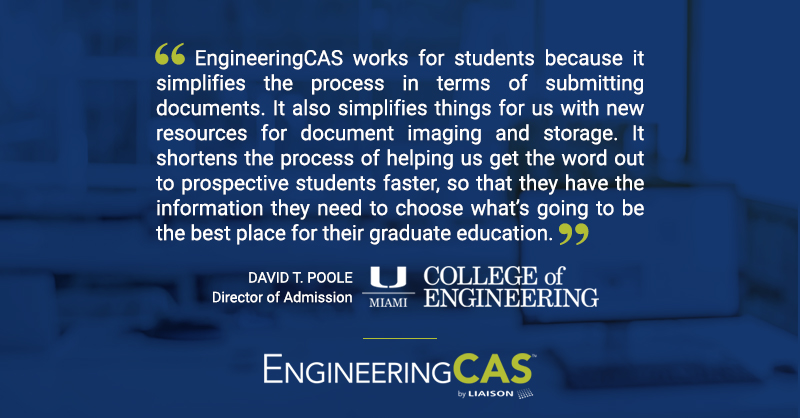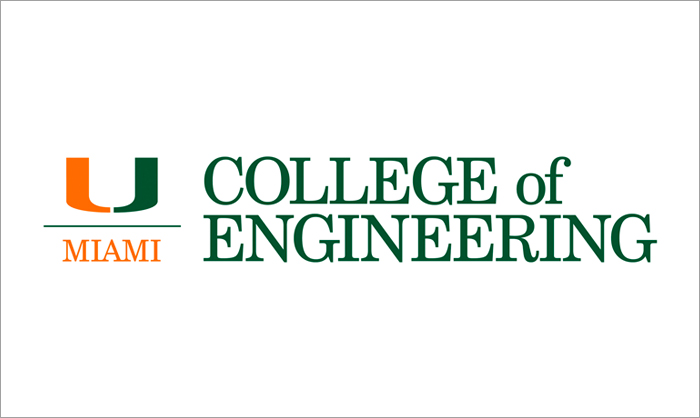An Interview with David T. Poole, Director of Admission at University of Miami College of Engineering
With the University of Miami College of Engineering (UMCoE) joining Liaison International’s EngineeringCAS™ in November 2018, Director of Admission David T. Poole already has a big-picture vision for the impact of EngineeringCAS not only at his school, but throughout the engineering field.
“The train was leaving the station and I wanted to be on that train, which is the future of making the process for admission for graduate studies in engineering one that is much more dynamic, much more user-friendly and one that provides us with the data to make critical managerial decisions,” says Poole, explaining UMCoE’s decision to join the Centralized Application Service (CAS™) for graduate engineering programs.
EngineeringCAS provides admission offices with an improved way to recruit, enroll and admit best-fit engineering students while saving money and better allocating staff resources each admissions cycle. Its platform is the manifestation of one of Liaison’s partnerships with more than 30 professional associations across academic disciplines; these partnerships have each introduced discipline-specific versions of Liaison’s CAS, the cloud-based student admissions solution, which has helped more than 31,000 programs on more than 1,000 campuses optimize their application and enrollment processes. All CASs are available at no cost to participating programs.
But what exactly is EngineeringCAS?
For applicants, it offers a single portal which streamlines their process for researching and applying to multiple programs of interest, offers a modern application experience that guides them through the process and provides 24/7 access to real-time updates on applications.
For programs and institutions, EngineeringCAS drives awareness, streamlines the application process and provides tools that enable targeted, personalized communications to those interested in a program; decreases decision-making times by providing a processing team to scan transcripts and package application components as an extension of an admissions staff; and provides insight into enrollment trends and performance on a campus through robust analytics and reporting tools.
“The potential that I see in EngineeringCAS is almost limitless,” Poole says. “It brings together all the aspects that you would need within enrollment management.”
Yet Poole, a member of the EngineeringCAS advisory board, is perhaps even more passionate about the CAS platform’s benefits for the entire engineering discipline, as well as graduate education as a whole.
“In higher education, the majority of the focus really has been on undergraduate education,” he reflects. “The graduate admission enrollment management community has been completely disjointed. There was nothing bringing that community together. One of the things that really attracted me to Liaison and the CAS was their ability to build communities within and across disciplines at the graduate level. They bring people together who are working with the same set of challenges, issues and budget constraints to share best practices in terms of how the CAS can assist both the students and the institution, but also to have a forum to discuss issues, concepts and ideas.”
Poole continues, “Many times on the enrollment management side in graduate education, we’re working in a vacuum. But the more we work together, the stronger we’re going to be as a community of educators and institutions. In the long run, that will only help the students we serve in their education and career preparation.”
From segmentation to unification
Under UMCoE’s previous enrollment management vendor, the engineering school maintained separate processes for gathering applicants’ biographical information, letters of recommendation, transcripts and test scores. The admissions office created and then manually updated spreadsheets to track applicants’ progress in the process, while yet another portal was used to communicate with applicants.
“Everything was very much segmented and used multiple systems to process each particular student,” Poole recalls.
Poole says he heard from other University of Miami programs, which were already using CASs, that “the students seemed to be really happy that they only had to submit one set of transcripts and one set of letters of recommendation, and were able to utilize the documents for multiple applications that they would have, while the programs themselves were even able to communicate directly to students within the same portal.”
“CAS had all of those things built into it, as a one-stop shop,” he says.
Furthermore, Poole was excited to learn that EngineeringCAS provided “an opportunity to log in just one time, to see data on the dashboard and view a group of students who may not have completed an application and start communicating with them rather than logging into another system and doing it.”
‘We killed lots of trees’
Before EngineeringCAS, Poole says there was “nothing paperless about our process.”
“We killed lots of trees,” he laments.
By making the admissions process completely paperless, UMCoE’s engineering degrees have joined the thousands of programs that save time and money by embracing the wave of the future through CAS.
“CAS provides several readily available tools more than we would ever have here,” says Poole. “The thing for all of us working in admissions is to take the technology and make it work for everybody. EngineeringCAS works for students because it simplifies the process in terms of submitting documents. It also simplifies things for us with new resources for document imaging and storage. It shortens the process of helping us get the word out to prospective students faster, so that they have the information they need to choose what’s going to be the best place for their graduate education.”

Streamlining communication
With EngineeringCAS, Poole explains, UMCoE’s admissions committee meetings “could take place regardless of whether a faculty member is sitting in an office above me or they’re sitting halfway around the world because they’re at a conference.”
“We are building out best practices for ourselves as we learn more about how other schools which have been using CAS have implemented the software and its functionality in reporting, scoring and communication,” he says, adding, “We’re throwing everything out that we did before, using something that already has a template in place and creating systems internally that will work best for not only the college overall but for programs regardless of their level, whether they’re masters or Ph.D. programs.”
Breaking down boundaries in higher education
Poole believes Liaison is driving a movement in which technology and communication “break down the silos” in higher education and enable institutions to rethink the ways they’ve traditionally done business.
“Liaison provides an opportunity where people have a voice that will be heard, and change does happen as a result of people being able to express themselves, whether it’s at an advisory board meeting, at a user conference or even just reaching out to the team there,” he says.
After all, technological platforms like EngineeringCAS don’t appear out of thin air — there are people behind them, Poole acknowledges.
“It’s not just words and charts and technology,” he says. “Hopefully, people who are exploring the possibility of joining a CAS will see they have partners — regardless of the fact that they may be working at other institutions — who ultimately have the same goal to prepare the best students in their discipline. In CASs, Liaison provides the forum for all students and institutions to use a common platform to reach their goals, and in return to help make the world a better place.”
Learn more about the community for graduate engineering programs at engineeringcas.org.

